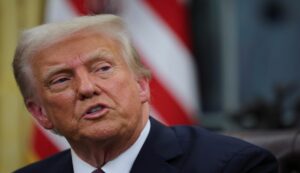US President Donald Trump had a significant impact on the birth rate during his first term
US: Researchers predict that U.S. President Donald Trump, in his first term in the Oval Office, had a major influence on birth rates; similar is predicted in his second term. Driven by low birth rates, the United States is among many great economic powerhouse nations experiencing a demographic drop.

Based on the Congressional Budget Office’s most recent projection published this year, America’s fertility rate is now expected to average 1.6 births per woman over the next three decades. This is well below the replacement level of 2.1 births per woman needed to keep the population constant without immigration.
Several times, notably at a campaign rally in December, Trump has spoken on this topic, stating, “We want more babies, to put it nicely.”
While Transportation Secretary Sean Duffy guided the Department of Transportation to give “communities with marriage and birth rates higher than the national average” first priority, Trump issued an executive order boosting access to in vitro fertilization (IVF) for Americans last month.
Following Trump’s first term, which ran from early 2017 to early 2021, University of California San Diego economists examined how his presidency had altered birth patterns across several states.
Published in the American Economic Review in 2022, authors Gordon B. Dahl, Runjing Lu, and William Mullins discovered in the research “Partisan Fertility and Presidential Elections” a “sharp and consistent increase” in Republican-leaning counties compared to Democratic ones.
This increase in Republican regions represented between 1.2 percent and 2.2 percent of the national fertility rate.
Mullins told the media report, “Birth statistics in Republican- and Democratic-leaning regions seemed comparable before the election. Starting about nine months after the 2016 election, however, those patterns started to vary; Democratic areas showed comparably lower birth rates while Republican counties showed steadily higher ones.”
But compared to non-Hispanics “for several months after Trump election campaign visits to that county,” Hispanic birth rates dropped, the study found.
Will Trump Affect Births Again the Same Way?
Mullins said he “expects” Trump will have a similar impact on births during this term, “especially because political partisanship—the fundamental driver of these fertility changes—has only become more intense since 2020.”
Dahl agreed in a recent interview with The Times when he said that although “Trump’s 2024 victory was less of a shock than in 2016, that could mean that the partisan fertility gap would be smaller this time,” adding that “America has become more polarized with the recent election” and “this is likely to amplify the effect this time around.”
Is it Trump’s or the abortion policy’s?
One thing that’s absent in all of the assessments I’ve seen linking Republican vote share and reproduction, Beth Jarosz, senior program director in U.S. programs at the Population Reference Bureau, told the media: “Policy. Over the last ten years, Republican states have passed more harsh prohibitions on abortion and contraception.”
She mentioned certain studies released last month evaluating the relationship between birth rates and abortion laws.
From universities like the Johns Hopkins Bloomberg School of Public Health, the University of California, and Carnegie Mellon University, it was conducted by various academics specializing in population, statistics and public policy.
With the largest estimated differences among subpopulations experiencing the most structural disadvantages and in states with among the worst mother and child health and well-being outcomes, the paper “US Abortion Bans and Fertility” concluded, “these findings provide evidence that fertility rates in states with abortion bans were higher than would have been expected in the absence of these policies.”
Positive Views on the Economic Situation
Mullins said, “Fertility might be reacting to variations in economic confidence. It is widely known that individuals who support the winning side in a presidential contest are more hopeful about the course of the economy, while those on the losing side get more negative.
“Moreover, the timing of these variations in optimism corresponds with the variations in fertility. Given the significant financial implications of the choice to have a child, this appears most likely to be the most crucial element.”
Likewise, Jennifer Sciubba, president and CEO of the Population Reference Bureau, informed Newsweek that “one likely explanation (though not the sole factor)” for the rise in birth rates in Republican counties following Trump’s election is “an increase in optimism about the future among Republicans after the electoral victory.”
“Republicans are more bullish about the economy right now (post-second electoral victory for Trump) than are Democrats,” she said. “Worrying about the economy depresses fertility, but not everyone is worried.”
Sciubba cautioned, however, “It’s impossible to foretell the political future… Therefore, we have to exercise caution not to interpret the link between demographics and party politics too seriously.
While these birth rate increases “certainly could contribute” to long-term demographic changes, Mullins said, “long-term shifts involve many other factors, and political coalitions and even partisanship can also change over longer horizons.”